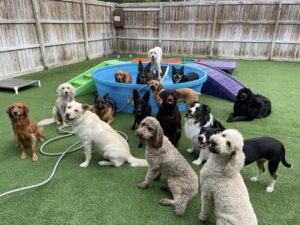
Play All Day Trainer, Jenny Lapke, is guest blogging this week. Here are her tips on how to achieve better loose-leash walking, for a less stressful and more enjoyable walk with your dog.
In addition to training classes and Day Training at Play All Day, Jenny offers in-home, private training through her business “The Good Dog Training Academy”.
Are you dreaming of your walks with your dog being “a walk in the park”? The calm, leisurely walk without pulling isn’t just something we see in movies, you can get there with your dog too! These training tips will help make your walk more enjoyable for you and your dog.
- Use a longer leash.
This is such a simple trick to make your walk more pleasant. Using a 6 foot leash is common, but it often doesn’t allow our dogs to have any room to explore or move around. By switching your leash to something a little longer, like 8 or 10 feet, your dog will be able to move and will reach the end of the leash less frequently, reducing the amount of pulling.
- Bring treats on your walk.
We often focus on what we don’t want our dog to do, but we often get better results when we let our dog know they are doing a good job. A walk is full of opportunities to give your dog a small tasty treat to reward them for doing what you would like them to. Stick some treats in your pocket as you head out the door and then reward your dog for walking close enough for the leash to have some slack in it or when they glance up at you. I often like to give treats by my side where I want my dog’s head to be. This will put your dog in a good starting and ending position, right where you want them! By letting your dog know you like the way he is walking, he will start to walk that way much more frequently. You might need to have really high value treats because there are many exciting distractions outside.
- Exercise your dog before your walk.
“But isn’t that what a walk is for?” I hear you, but walking in a straight line is not natural for dogs. As they are learning to walk politely, it can be hard for your dog to walk calmly if they have pent up energy. To make your walks easier, especially early on in the learning process, spend a little time playing with your dog before setting out on your walk. You can play tug, chase, fetch, or even just let your dog run around. This will get some of your pup’s energy out, so it is easier for them to walk next to us.
- If your leash is tight, stop moving.
If we keep moving while the dog is pulling, we are actually reinforcing the pulling and your dog will pull more frequently. When your dog’s leash gets tight, stop moving and wait for your dog to glance back at you. Your dog might not look all the way back at you, but that is just fine. Any glance in your direction will be enough to reward with a treat by your side and then start to walk again.
- Let your dog sniff!
Dogs love to sniff while on a walk, and it is actually good for them too! Sniffing will help provide your dog with mental stimulation that just as important and beneficial as physical exercise. In fact, your dog might be more tired if you allow them to sniff along their walk than if you go jogging with them.
- Practice walking before you go into the big wide world.
You can always practice walking your dog inside! You don’t need a large space to start. Just take a step or two at a time, and reward your dog for being by your side as well as looking up at you, just like you would outside. By practicing inside, you allow your dog to learn what you would like him to do before asking for those behaviors in a more distracting environment. After you master walking inside, try walking someplace like your backyard before going to the park.
 As most of you know, Kate added to her family twice this past year. Dutton and Wheeler, sweet and beautiful Labrador Retriever puppies, have filled her days with activity, a little insanity, big Vet bills, and a lot of joy. All of this puppy energy has had Kate thinking a lot about home enrichment activities. Her research and passion for this topic have benefited Play All Day as well. So I thought it would be a good time to pass some of this information along to you. Join us today as we delve into all things enriching to a dog’s world.
As most of you know, Kate added to her family twice this past year. Dutton and Wheeler, sweet and beautiful Labrador Retriever puppies, have filled her days with activity, a little insanity, big Vet bills, and a lot of joy. All of this puppy energy has had Kate thinking a lot about home enrichment activities. Her research and passion for this topic have benefited Play All Day as well. So I thought it would be a good time to pass some of this information along to you. Join us today as we delve into all things enriching to a dog’s world.
We will explore why licking, chewing, sniffing, problem-solving, searching, and social time can help your dog to live a more enriched life.
For most of our dogs, their lives revolve around our lives. Their schedule is dictated by us, down to when they eat, sleep, sniff, and toilet. Very little is really in their control. It is no wonder they are so happy to see us and get excited when our attention turns their way. Sleep occupies a large part of a dog’s schedule….most of it needed, but part of it just because there is nothing better to do. By considering an enrichment plan for your dog at home, you can not only add to your dog’s happiness, but you can add to their mental and physical health…and perhaps make their day a little less mundane. And I will wager that you will see some benefits as well.
Licking:
 Most dogs love to lick. There are many reasons that dogs lick and one of them is because it feels good. It is suggested that when a dog licks, endorphins are released and bring pleasure. Whatever the reason, we know that dogs like to lick and this can be a target for some of your enrichment activities at home. We have used peanut butter stuffed Kongs in our boarding facility since we opened. We put peanut butter in them and freeze them. Our hotel guests get them at bedtime. We found that they are helpful in helping a dog to relax at a stressful time in their stay…a time when they are usually snuggling up to Mom and Dad at bedtime. The licking of the peanut butter distracts the dog and possibly releases endorphins and reduces the stress of being away from home. And most dogs love food, so the peanut butter is a nice treat in addition to the benefits of licking. You can provide licking for your dog in many ways. The stuffed Kong, lick mats, frozen treats, and special lick toys are a few.
Most dogs love to lick. There are many reasons that dogs lick and one of them is because it feels good. It is suggested that when a dog licks, endorphins are released and bring pleasure. Whatever the reason, we know that dogs like to lick and this can be a target for some of your enrichment activities at home. We have used peanut butter stuffed Kongs in our boarding facility since we opened. We put peanut butter in them and freeze them. Our hotel guests get them at bedtime. We found that they are helpful in helping a dog to relax at a stressful time in their stay…a time when they are usually snuggling up to Mom and Dad at bedtime. The licking of the peanut butter distracts the dog and possibly releases endorphins and reduces the stress of being away from home. And most dogs love food, so the peanut butter is a nice treat in addition to the benefits of licking. You can provide licking for your dog in many ways. The stuffed Kong, lick mats, frozen treats, and special lick toys are a few.
- The stuffed Kong has been around forever in the dog world and is a good option. The biggest drawback is that they are not easy to clean if your dog does not fully eat all of the stuffing. You will need an old toothbrush and a little bit of elbow grease to keep it clean in between uses. Also, some dogs do not like the shape and give up on it a little too easily.
- Lick mats are a great entry-level lick toy. They are a silicone mat with some sort of texture. You can smear peanut butter, canned dog food, or anything creamy onto the mat and the dog will lick it off. They clean easily, but the distraction time is not great unless you keep refilling it. Freezing a loaded lick mat will help to increase its duration.
- Until you know how your dog will interact with a lick mat, I recommend supervising. Some dogs will try to eat the mat to get every last drop.

- Making frozen broth treats is a fun way to let your dog lick. They can last a bit longer based on how big they are. But they can be messy if they melt faster than your dog licks. Best to try this one outside at first.
- Our new favorite at Play All Day is the Pupsicle by Woof. This one is easy to use and clean. And it can give up to 30 minutes of lick time. My dogs are a bit obsessed with ours right now. One of the nice features of this toy is that you can buy ready-made refills or you can make refills using their silicone freezer tray. Learn more here.
- One of Kate’s new favorites is the West Paw Toppl. It is very much like the Kong, but much easier to clean and has another layer that can be added to increase the difficulty and duration of licking. Here is a video on the Toppl.
I love licking enrichment activities for my dogs. It is Willow’s favorite activity by far. Not only does licking provide some enrichment to your dog’s life, but it is also a great distraction tool. Willow is notorious to all of our friends who visit our house. She demands to be the center of attention and makes a lot of noise when she is not. We have found that licking activities are a great distraction for her. So when company arrives, she gets a licking toy (love the Pupsicle for this) and she is happy and distracted.
Please note that not all licking is healthy. Obsessive licking can be a sign of a psychological issue or a medical issue. If you notice that your dog is licking everything or licking too much of the time, you should consult your Veterinarian or Behaviorist. Please feel free to discuss this with us if you need help determining just how much licking is too much licking.
Chewing:
Just like licking, chewing can be very pleasurable for a dog. A dog’s mouth and jaw are designed to chew. Dogs enjoy it and there are a lot of options out there. But providing safe chewing options does take a bit of thought and planning.
- I am not a fan of the commercial dental chews that are so popular now. There is an awful lot of synthetic material in the chews and they are not very digestible. Most dogs are able to break off big chunks at a time while chewing. If these pieces are swallowed, they sit in the stomach for a long time and can cause stomach upset. This puts the stomach into a continued state of acid overproduction. This same thing can happen with most hard chews in which a dog can break off bigger pieces and swallow. I have found that more natural chews such as bully sticks and Himalayan chews dissolve and digest faster than the commercial dental chews. But even with that, they can cause stomach upset. I still give my dog bullysticks but I monitor them closely and only allow them to consume small bits at a time. And if stomach upset occurs, this is an indication that it may not be the best chewing option.
- Hard synthetic bones can be a good chewing alternative. But you must monitor this closely. If your dog is an aggressive chewer, pieces can be broken off and swallowed. This is not very common but does happen. It happens more frequently as the chew gets older.
- Antlers are another good chewing option but must be monitored closely as well. They are hard and if a dog is too aggressive, tooth damage can occur.
- My favorite chew is a raw marrow bone. They are hard and satisfying for a dog, but not so hard that tooth damage is as likely with an antler. They are very satisfying to a dog as they typically have some tissue on the outside and the dog can shred the tissue from the bone which is a natural behavior. The dog also gets to lick to get the marrow from inside of the bone.
- A few rules to follow with chew items:
- The chew should be a few inches wider than the width of the dog’s mouth. Anything smaller can be swallowed and choking is a hazard.
- Bones should be fed raw. Cooked marrow bones will splinter and can be a choking hazard.
- Until you know how your dog will interact with a new chew, monitor them closely. I do this for a few sessions. And anything that has the potential to break off and be swallowed, I always monitor.
Sniffing:
 If I were to offer you just one enrichment activity, this would be the one. I think all of them are important in developing a well-rounded program for your dog, but I think sniffing is the one that is most important to dogs and one that is so often restricted by parents (often innocently).
If I were to offer you just one enrichment activity, this would be the one. I think all of them are important in developing a well-rounded program for your dog, but I think sniffing is the one that is most important to dogs and one that is so often restricted by parents (often innocently).
Not only is sniffing the most important enrichment activity for your dog, it is also the easiest for you to provide. Simply put, let your dog sniff. Awareness is half the battle here…knowing that your dog needs to use his nose. Our lives are often a rush. Get up, get ready for work, let the dog out, feed the dog, off to work. It can be hard to wait for your dog to get done sniffing, and we often rush them along, telling them to hurry up. If you can budget two extra minutes into your morning routine, just to let your dog sniff at will, it is beneficial.
When you go for a walk with your dog, share the time with them. If you are truly on your walk for the dog’s sake, incorporate sniffing into your plan. Physical exercise is important for your dog and walks are a great way to provide that. I would suggest that sniffing is every bit as important to your dog as physical exercise. The majority of your dog’s perception of the world is coming from his nose. Taking that away from our dogs is similar to us losing our sight. I recently saw a quote about us rushing our dogs through their sniffing (sorry, can’t remember where I saw it). It likened us yanking our dog away from a good sniff to a human only being given 30 seconds to view one of the Seven Wonders of the World. Perhaps that’s a little dramatic, but you get the point.
I wrote a blog on this topic several years ago and it is still true today. You can read it here. “Whose Walk is it Anyway?” In the post, I talk about sharing your walk with your dog, allotting time for sniffing and time for exercise. Since I wrote it, I have taken it one step further. Now I suggest incorporating entire walks to the dog for sniffing alone. Set a duration in your mind and then let your dog choose the route and let him sniff as much as he wants. You may not walk a block, but your dog will be thrilled with the walk. Two 20-minute sessions of this each week will do wonders.
Finding:
 Finding is an extension of Sniffing, in my opinion. I’m giving it its own section here because it can be a great enrichment activity to use in your house or yard. Finding can be done with toys, food, or people.
Finding is an extension of Sniffing, in my opinion. I’m giving it its own section here because it can be a great enrichment activity to use in your house or yard. Finding can be done with toys, food, or people.
It is my boy Cygnus’ favorite activity, right up there with swimming. Cygnus has a basket of “babies” which are all his stuffed toys. Cygnus adores his babies and tries to be fair in giving them all some playtime each week. Our “Find Your Baby” game consists of me asking Cygnus for a sit/stay and then hiding his baby somewhere in the house and then releasing him to find his baby. He uses a combination of memory and sniffing to find his baby. Memory is displayed when he goes to some of our more frequent hiding spots before using his nose. Once he realizes they are not there, he starts using his nose to track it down. We do not use a food reward for this game because the game itself and finding his baby is the reward. We’ve been playing this game his entire life and we did not start with a sit/stay and the hiding places were very simple. As his training skills increased and his finding abilities increased, I increased the difficulty level.
Start simple. If your dog does not sit/stay, use a closed door or have someone hold him while you hide the toy. Let your dog have success with simple hiding spots at first and then make them more difficult. You may be tempted to help your dog find the toy, but resist. If he is really struggling, just casually stand in the vicinity of the toy as a guide. If you constantly help, your dog will look to you and not his nose.
If your dog is not toy-motivated, use food treats to hide. You can hide a tasty treat somewhere in the house to find. I know some folks who will throw their dog’s entire meal into the grass and let the dog find each piece of kibble. Snuffle mats are a simple form of find it. Kibble is hidden within the mat for the dog to sniff out and eat. Family members are also great to “find” for your dog. This is such a great activity and can be played indoors during bad weather. When we go on hikes, my husband will hold Cygnus and I will hide in the woods. Great fun for all when he finds me. There are so many options for Finding games and your dog will love you for it.
Problem Solving:
 I look at problem-solving as an exercise for the brain. And just like sniffing, it can tire a dog out as easily as exercise. I admit that I am guilty of helping my dog solve problems too often. Lately, I’ve been stepping back and letting him figure it out. So when a ball goes under a piece of furniture, I’m letting Cygnus figure out how to retrieve it. When something he wants is on the other side of a barrier, I’m not showing him the way to get beyond the barrier. It’s really cool to watch your dog’s problem-solving abilities. Look for ways that you can create “problems” for your dog to solve in everyday life.
I look at problem-solving as an exercise for the brain. And just like sniffing, it can tire a dog out as easily as exercise. I admit that I am guilty of helping my dog solve problems too often. Lately, I’ve been stepping back and letting him figure it out. So when a ball goes under a piece of furniture, I’m letting Cygnus figure out how to retrieve it. When something he wants is on the other side of a barrier, I’m not showing him the way to get beyond the barrier. It’s really cool to watch your dog’s problem-solving abilities. Look for ways that you can create “problems” for your dog to solve in everyday life.
For enrichment, you can help your dog use his brain by allowing him to solve everyday problems on his own. You can also offer puzzles. There are puzzles that you can purchase and puzzles that you can make at home. The key to puzzles is to make them easy at first so that your dog can succeed and then add complexity as he gets better at solving them.



One of the trendiest DIY puzzle toy in the past few years has been the folded towel. Take a peek at the YouTube video to make your own. If you are not interested in making your own, PAD will have an option (The Snuffle Knot) in our retail market soon. Kate has tried it out with her boys and it was a hit.
Socializing:
 Being social is another form of enrichment. If your dog is attending daycare, he is getting socialization. But even if you attend daycare, different forms of socialization will broaden your dog’s world. If appropriate, meeting new dogs and new people will open your dog to new experiences and new scents.
Being social is another form of enrichment. If your dog is attending daycare, he is getting socialization. But even if you attend daycare, different forms of socialization will broaden your dog’s world. If appropriate, meeting new dogs and new people will open your dog to new experiences and new scents.
And if a car ride is available, we all know how exciting and tiring a car ride can be. A trip to an outdoor café is very enriching. “Growing” your dog’s world is a wonderful variation of enrichment.
We love our dogs. And we want to do the best for them. A program of enriched activities throughout the week can benefit your dog. And never underestimate just being with your dog, truly being with your dog, not distracted by TV or social media. Lay on the floor with him and be present. Give a massage. Read from your book out loud. Listen to some music. Just yesterday, I made a big deal of preparing peanut butter sandwiches for my kiddos. I sat on the couch with a jar of peanut butter and a bag of their treats. I carefully applied peanut butter to the cookie (had to make a big show of it) and had a snack session. They loved it. Enrichment comes in many forms and doesn’t have to be difficult. You just have to remember to do it. Your dog will thank you.


Sample Enrichment Calendar:
Sunday:
Free sniffing for 3-5 minutes in the morning and before bed
A game of “Find It” for 10 minutes in the afternoon
A car ride to a new park for a walk
Monday:
Free sniffing for 3-5 minutes in the morning and before bed
A lick toy when you leave for work
A chew toy during TV time
Tuesday:
Free sniffing for 3-5 minutes in the morning and before bed
A lick toy when you leave for work
A sniff walk for 15 minutes with no rules
Wednesday:
Free sniffing for 3-5 minutes in the morning and before bed
A lick toy when you leave for work
A puzzle toy while you watch TV that night
Thursday:
Free sniffing for 3-5 minutes in the morning and before bed
A lick toy when you leave for work
Dinner served outside
A special chew while you watch TV that night
Friday:
Free sniffing for 3-5 minutes in the morning and before bed
A lick toy when you leave for work
A 10 minute sniff walk when you get home from work
A snuffle mat filled with treats when you leave to go out for date night
Saturday:
Free sniffing for 3-5 minutes in the morning and before bed
A 30 minute walk in a new place, with 15 minutes of walking and 15 of sniffing
Visit a family member or friend, or have friends visit. Give a lick toy to settle your dog when company first arrives to help him settle in.
All Dog Daycares Are Not Created Equal….Your Guide to Evaluating the Best Option for your Dog
 We are all feeling the effects of an increased cost of living. I’ve really noticed it in the past year and based on what I’m hearing, you are all feeling it too. Some of the things I’ve caught myself saying in the past few months is “Did I really just spend that much money on a cup of coffee?” “Wasn’t this product 20% less the last time I bought it?” “Utility costs are crazy right now.” Why did my insurance costs double?” “Wow….going out to eat is getting really expensive!”. As a result, I have started looking at what is in my control to reduce spending and what is not? What things mean more to me than others? Everyone is different and we all have different priorities. And as we make decisions on where our discretionary dollars are spent, we focus on what is important to us and what value we are getting from our dollars spent.
We are all feeling the effects of an increased cost of living. I’ve really noticed it in the past year and based on what I’m hearing, you are all feeling it too. Some of the things I’ve caught myself saying in the past few months is “Did I really just spend that much money on a cup of coffee?” “Wasn’t this product 20% less the last time I bought it?” “Utility costs are crazy right now.” Why did my insurance costs double?” “Wow….going out to eat is getting really expensive!”. As a result, I have started looking at what is in my control to reduce spending and what is not? What things mean more to me than others? Everyone is different and we all have different priorities. And as we make decisions on where our discretionary dollars are spent, we focus on what is important to us and what value we are getting from our dollars spent.
What on earth does this have to do with choosing a daycare? Why are we discussing inflation instead of dog behavior, dog safety or staffing? Believe it or not, I do have a relevant point to make here. When we are in the financial situation that we are in today, there are choices to be made. Is daycare for my dog a priority? If so, should I choose the least expensive option? What am I getting for my money? These are questions you have probably asked yourself in the past year. So, in the spirit of our blog series on choosing the right daycare for your dog, I feel that it is important to address these questions.
Should Dog Daycare Be a Financial Priority?

Obviously, I am not the right person to answer this question for you. Just like you should not be the person to tell me if buying yarn for my knitting projects should be a financial priority for me. Although, I’m sure my husband would love for someone to tell me that it should not be a priority. So, this is a decision you must come to yourself. But I can point out and remind you of a few of the benefits of dog daycare, as you make this decision.
- Physical exercise. A day of daycare can get your couch potato up and moving. Conversely, a day of daycare can help to settle that overactive puppy down a bit.
- Mental exercise. With the right daycare programming, not only will your dog get physical exercise, but will also get mental exercise. I believe that mental exercise can wear a dog out as easily as physical exercise. And mental stimulation can be beneficial to aging dogs.
- With the right daycare program, your dog will learn basic skills such as impulse control, greeting manners, and name recognition.
- Social skills. Coming to daycare and being out in the world, riding in the car, interacting with people and other dogs helps to create good social skills that can be used in other social settings.
- Dog Interaction. Interacting with other dogs is beneficial to your dog’s psyche (assuming, of course, that they enjoy that). Dogs speak Dog and no matter how hard we try; humans cannot give a dog the same experience as interacting with other dogs.
- Time away from home. A good daycare experience can help dogs feel safe away from their home and their people. There will be times when your dog will need to be away from home. Daycare helps to prepare them for that.
- Boarding. I feel it is a great comfort to your dog to board in a place that already feels like a second home. Boarding is stressful no matter what, but a day of play with people and dogs you know can make that nighttime stay away from home a lot less stressful.
Assessing Dog Daycare Value
Pricing: Pricing is a common component that people look at when assessing value. But I would suggest that it can be a sneaky indicator of value. If you look deep enough, price can tell you a few things about the daycare (good and bad). Daycares typically have the same fixed costs of facilities, utilities, insurance, supplies, etc. When a daycare has a much lower price for daycare than others in the community, what does that mean? There are a few variables that give us information.
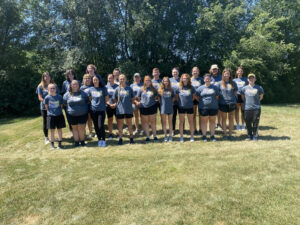 Staffing is a variable, and a low daycare price can indicate lower staffing levels. Staffing is the highest cost at Play All Day and accounts for 50 – 55% of our revenues. In the business world, this would be looked at as “bad business”. Healthy is considered less than 30%. I network with like-minded, successful dog daycares across the country and without exception, they all have a similar payroll to revenue ratio. If you are simply “managing” dogs, it takes fewer staff members. On the other hand, giving dogs and their parents the best experience possible takes people; people who are committed employees and fairly paid, which leads to higher staffing costs. And this affects the daycare price.
Staffing is a variable, and a low daycare price can indicate lower staffing levels. Staffing is the highest cost at Play All Day and accounts for 50 – 55% of our revenues. In the business world, this would be looked at as “bad business”. Healthy is considered less than 30%. I network with like-minded, successful dog daycares across the country and without exception, they all have a similar payroll to revenue ratio. If you are simply “managing” dogs, it takes fewer staff members. On the other hand, giving dogs and their parents the best experience possible takes people; people who are committed employees and fairly paid, which leads to higher staffing costs. And this affects the daycare price. - Another variable is the primary service line of the daycare. Play All Day is a daycare first and foremost. We offer boarding as a value-add for our clients, but we do not offer boarding outside of our regular client base. Most of the daycares in our community are boarding based and offer daycare as a part of their value-add to their boarding clients. This model means that daycare is not the primary focus, and it means that there is an ever-revolving clientele of dogs coming in and out of the playgroups. We had this model in our first few years of being open and to me, it was not a good product. It was not a product I would use for my own dogs. PAD could be much more profitable if we offered open boarding services, but it would not be possible for us to offer the level of service that we do now.
- Many daycares offer a “First Day Free” option to attract new clients. Play All Day has stayed away from this type of incentive, simply because we are looking for clients who will commit to our program. We do not offer same-day, walk-in daycare evaluations for this same reason. The care and consideration we give to all our new dogs takes extra staffing time. We know that you value the result, so we value the expense that it takes to provide it.
Services: The deceiving part of just looking at the daily cost of daycare is that it does not tell what is included in that daily fee. A daycare that costs $2.00 less per day may look like a value, but then you realize that there are hidden fees for some services and that some services aren’t available at all. And what is the quality of the services you are receiving?
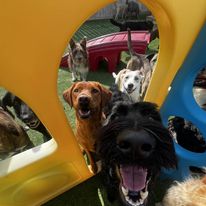 As you evaluate a dog daycare and the costs associated with it, look to see what is included in the daily cost. Is human interaction with your dog included or is that an add-on? Is your dog receiving training? Is someone assessing your dog’s behavior and well-being each visit? Is someone putting hands on your dog and assessing them head to toe? Are cuddles and affection provided? Are fun things like birthday parties and fun pictures included? Are there enriching activities such as bone time, toy play, and puzzle games? Are there dog experts on board to answer your dog-related questions? Play All Day is proud to say that all these services are part of our daily fee.
As you evaluate a dog daycare and the costs associated with it, look to see what is included in the daily cost. Is human interaction with your dog included or is that an add-on? Is your dog receiving training? Is someone assessing your dog’s behavior and well-being each visit? Is someone putting hands on your dog and assessing them head to toe? Are cuddles and affection provided? Are fun things like birthday parties and fun pictures included? Are there enriching activities such as bone time, toy play, and puzzle games? Are there dog experts on board to answer your dog-related questions? Play All Day is proud to say that all these services are part of our daily fee.- A la Carte services are all the rage in the dog daycare business world. Pet services consultants tell their clients that nothing besides basic care should be provided in the daily daycare cost. That has never sat well with me and goes against our mission of providing a fun, safe, and enriching environment for the dogs in our care. If we hold to our mission, that means we create this environment for all the dogs in our care, not just the ones whose parents pay extra for it.
- I encourage you to really evaluate the cost per day of daycare thoroughly. Don’t just look at the number. Dig deep and see what your dollars are getting you. Go beyond looking at the text and pictures on the website. Marketing can be so deceiving. Question the daycare and ask them what their claims of enrichment or interactive daycare mean. Ask for specifics. Can they back up the claims made on their website and advertisements? I love it when prospective clients ask me these questions. Don’t be shy. Your decision affects the well-being of your dog.
Play All Day will never be the “cheapest” dog daycare in the area. We offer so much as a part of our daily experience, things that you will not get at other daycares. We are proud of that and we know that once people experience the Play All Day difference, a few extra dollars per week will seem like an excellent investment in their dog’s well-being.
Thank you for joining me for this 4-part series on evaluating a dog daycare. I hope you were able to learn a thing or two. And I sincerely hope that, if you are seeking dog daycare for your dog, you have a guide to help you in making a good decision. If you are seeking dog daycare in the Peoria IL area, I hope that this guide will point you in our direction and that you will become a part of the PAD family.
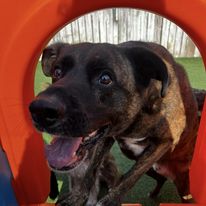
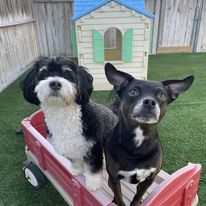
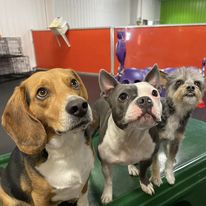
Not All Dog Daycares Are Created Equal…Your Guide to Evaluating the Best Option for your Dog
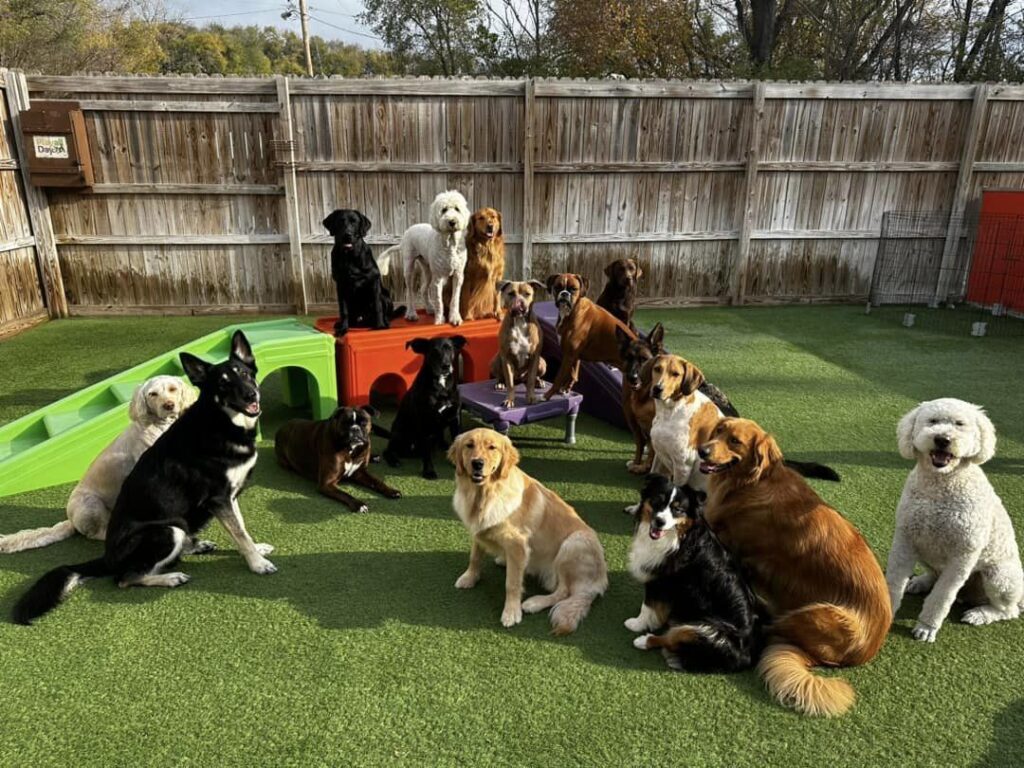
Welcome to part 3 in our blog series on how to evaluate and choose a dog daycare. In our first two posts, we discussed the features of a safe dog daycare and how important proper staffing is for a well-run facility. Without question, safety is the top priority when considering daycare for your dog. One of the things that really plays into a safe daycare is the programming that is provided.
Just what am I talking about when I bring up programming? Quite literally, it is the scheduled events of each daycare day. What is on the agenda for each dog when they attend Play All Day? Our programming has evolved over the past 13 years, and we really hit our stride in the past 5 years. I believe it is what separates us from other daycares in our area. It was that special ingredient that moved us from a good dog daycare to a great dog daycare. Prior to 2018, we did have programming. There were scheduled events throughout the day, but for things like training and enrichment, it was at the Dog Handler’s discretion as to whether or not their group participated. We paid attention and we saw that those groups receiving the extras in their day did better overall, in terms of arousal control, impulse control, and having a good time in playgroups. The dogs seemed more relaxed and there was much more focus from some of our overactive kiddos.
With the evidence before us, we saw an opportunity to really improve the experience of all the dogs under our care. So, we did. We set expectations with our team, implemented consistent programming across all our playgroups and watched all the positive changes that came along with it. This post will be structured a little differently than our past two. Rather than giving you questions to ask a potential daycare, I will be outlining Play All Day’s programming and what benefits it brings to the dogs.
Our programming falls under 5 major categories; Dog management, Training, Free-Play, Observation, and Rest.
Dog Management: This category pertains to the management of the dogs throughout the day to make sure things run smoothly and all the dogs are safe.
- Check-in and Check-out are prime management times. Other activities such as play and training occur during this timeframe, but the main priority is getting the dogs settled into group in the morning and then getting the dog out of group during check-out. As mentioned in previous posts, this is a high-arousal time. Proper management of the dogs, including reading body language, interpreting vocalizations, reading energy levels, and managing space is the goal. Having the proper physical setup in your facility helps a lot, but human intervention is most important. We’ll talk more about training later in this post. But it is so closely tied to management that it should also be mentioned in this section. Calling the dogs by name (Recalls) during check-in is valuable and is used daily to manage the group as they settle in each morning. This is a behavior that we teach and work on regularly.
- Throughout the day, dog management is required. Even the best run playgroup will have times when the energy levels get too high, and the dogs get over aroused. That is when management is required. This can be as simple as calling one of the dogs to you and asking for a few training behaviors, with rewards. This can push the re-set button on a dog who is getting over aroused. But there are times when the dog is too far gone, and these measures will not help. The next step is to calmly leash the dog and take them on a short walk around the play area or implement a short crate timeout.
- There are also times when the whole group, for whatever reason, will just spontaneously get over aroused as a whole. These are challenging times for the dog handler, but intervention usually does help. The trick is to be attuned to the group and manage it as soon as it is evident. Intervention can be as simple as opening the door to the outside play area and changing the scenery. Or it can be handled with a group exercise, such as a group sit/stay. When all else fails, strategic crate timeouts will solve the issue.
- Our goal is to not get to the point where management strategies such as crate timeouts are needed. Effective management is catching certain dogs, or the group as a whole, before things get out of control. If you can catch the dogs while their brains are still working, most issues can be avoided with simple training exercises.
- Here is a great example of training used in dog management. Zoomie Stop
Training: Training occurs throughout the day in our playgroups. As mentioned above, it is a big part of group management. We also consider training a part of our enrichment program. It works the dogs’ brains and offers mental exercise. I believe that mental exercise is every bit as important as physical exercise in dogs.
- PAD Secret: When we first started training the dogs in our daycare, it was purely selfish. As a dog handler myself, I did not want 80 # dogs jumping up on me, so I started training them not to. I saw quickly that the dogs not only didn’t jump up on me, but they started focusing more on me when I offered training. Now we offer training not only for our benefit, but also for the benefit of the dogs and their parents.
- Our first real efforts with group training exercises started many years ago when we began participating in the Doggie Daycare Olympics. This was a virtual event put on by a daycare professional organization. Their premise was that any good dog daycare handler should be able to get their dogs to do a group sit/stay, should be able to get all dogs to come when called, and should be able to keep their dogs from charging the playroom gate when left opened. To be honest, these things seemed impossible when we first started, but we quickly found out that the dogs enjoyed the exercises, and that our groups were much better behaved when we worked on the Olympics.
- For years, we just did the Olympics once a year and our staff would train these exercises in the weeks leading up to the Olympics and then stop training after they were complete. But some of our staff liked it so much that they kept going with it and eventually pushed the boundaries of what we thought could be trained in a group setting. Based on the good effects we saw with these groups, we then made it a part of each group’s day, every day. Training is now part of our employee training, competencies, and continuing education program. It is a part of our culture.
- Consistent attendance is key to being able to train dogs in a group setting. Training needs to begin in low distraction environments and in small steps that set the dog up for success. That can be challenging in a group play setting. The dog handlers choose their training times wisely and it is usually late in the morning or after the excitement of waking up from nap is over. By training during these quieter times, the handlers are creating skills that they can use during high arousal times. It is a process and takes our new dogs several weeks to master.
- Links to some training videos: Gate Boundary Leave It This next video is a really great example of Ciera getting creative and taking our programming to the next level. Next Level Training
 Free Play: Daycare can’t be all about work and learning. We are called Play All Day after all! Our programming does allow for free-play and fun & games throughout the day.
Free Play: Daycare can’t be all about work and learning. We are called Play All Day after all! Our programming does allow for free-play and fun & games throughout the day.
- Playtime is divided between indoor and outdoor play, depending on the weather. In the summer there are pools and other water activities.
- Winter provides its own fun with snow play.
- On rainy days, bubbles provide a fun source of entertainment and enrichment for the dogs.
- Play equipment is provided in all our play areas. It is fun for the dogs to use the equipment, but more importantly, it provides social distancing for dogs who need it. When we see a dog go under the tunnel of the play equipment, it usually means that they are trying to create a little distance between themselves and the dog that is interested in them. Jumping up on the play equipment does the same thing. By creating distance, the dog is able to slow things down and assess the situation. From there, they can decide whether to engage in play or take it slow. Here is a great example from our puppy social. Nobel & Benny
- For dogs that enjoy it, we do offer some agility play, using jumps, tunnels, and hoops. Some of our staff are very creative in creating agility courses from what they have in the play areas.
- Toy play is allowed in small doses throughout the day. Toy play used to be a bigger part of our programming, but we found that it became a crutch for our staff to use to keep the fetchers occupied. It excluded the non-fetching dogs and replaced time spent teaching training exercises. Now toy play is a small part of the day for those that love it.
- Bone time is provided daily. Low value chew bones are offered to the group and oftentimes the dogs will choose to settle and chew quietly for a time. Chewing is calming and it is therapeutic for a lot of dogs.
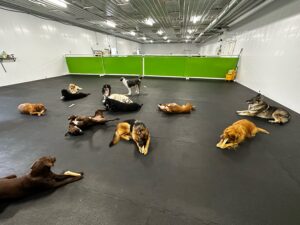
- I’m told that dance parties are a part of playtime as well and I may have seen a video recently of Mae dancing across the screen. Dance Party The staff has to have fun too.
- Dog/dog play is a big part of daycare and when supervised properly, provides great socialization opportunities. Dogs speak dog. And no matter how well trained a human may be, they can’t speak dog the way a dog can. I have always likened this to a human living in another country and not knowing the language. Imagine how excited you would be when someone arrived that finally speaks your language. We, as humans, can learn to speak dog, but we will never do it as well as another dog.
- Some dogs don’t love dog/dog play and that’s OK. We find that our non-playing dogs get a lot out of daycare. They love to sit and watch and be a part of the activity from a distance. Their parents tell us that they get just as excited on daycare days as dogs who play non-stop do. Understanding this is crucial for good programming. Meeting each dog where they are and helping them to have the best day possible is our duty at the daycare.
- Snuggles, cuddles, scritches, scratches, licks, and belly rubs are all a part of our programming as well and should be included in every daycare’s daily schedule.
- Here is a link to some beautiful free-play. And here’s more with Clem & Eric.
Observation: While not as much fun as bubbles and dance parties, observation is a responsibility of our dog handlers. From the moment a dog walks in until they leave at the end of the day, our handlers are monitoring for physical issues, behavioral issues, and illness.
- Because of our consistent attendance, our team knows the dogs in their playgroup and sense when something is off. It can be something as simple as a dog not wanting to play with his usual buddy or taking more rest breaks. Perhaps the dog is drinking more water than usual, or their poops are not the normal consistency. Is the dog grumpy when others come near? Is there a slight limp? These things are noticed by our team and reported to our leadership team and ultimately to the parents. It is not unusual for our team to notice something that the parent may not have noticed.
- In addition to observing throughout the day, our team performs hands-on body checks twice a day. The dog is invited up on to the play equipment and the handler checks out the dog from head to toe, looking for injuries, lumps, bumps, or anything else unusual. Not only does this allow us to find issues that might have happened during daycare, but also may identify an ongoing health issue. And it is a great exercise in desensitizing dogs to being handled.
- We are also watching for behavior changes from week to week. These changes can indicate many things:
- If a dog is in pain, they really can’t verbalize that to us. But they can show that they are not comfortable with other dogs approaching them or perhaps they do not want to roughhouse play like normal.
- Just as with pain, illness can manifest itself in behavior changes as the dog protects its body or conserves energy.
- Vision issues. Aging dogs can have vision changes, and this does affect how they interact with other dogs.
- Home issues. When we see behavior changes at the daycare, we discuss this with the parents. Once we rule out a health issue, we often hear that there are many changes going on at home. New babies in the household, new jobs or moving, long term visitors, new dogs or cats in the home, illness in the family, etc. are some of the home issues that we have identified as a cause of behavior changes while at daycare.
Rest Periods: I strongly believe that structured rest periods should be a part of all daycare programming.
- A midday nap in which all dogs are crated is essential to our program’s success. Dogs, just like toddlers, need some help regulating their energy output.
- In addition to midday naps, some dogs do need a 5-minute rest break here and there throughout the day. This is especially important for puppies less than 6 months old.
- Who doesn’t love a tired dog at the end of daycare? But I will tell you that there is a good tired and a bad tired for dogs. A good tired comes from a structured day that has a mixture of training, free-play, and rest periods. Bad tired comes from exhaustive non-stop play and stress from overdoing it. Think of it in human terms. It’s a great feeling of being tired when you have had a nice day outside, busy socializing with friends, and perhaps some hiking or other exercise. It’s not such a great tired when you have exhausted yourself working non-stop on a physical and/or mental project.

PAD Extras: The components of good programming that I have mentioned so far focus on the dogs. Good programming should also include some fun stuff for the parents.
- Pictures and videos showing parents what is happening during a day of daycare.
- Birthday parties, at no extra charge, for a special day. Buffy’s Bday party
- Special holiday pictures with silly accessories. OK, I admit it, this may not be the dogs’ favorite thing, but the parents sure love it.
- Enjoy this little blooper reel of Katydid during our St. Patrick’s Day photo shoot. Katydid
Safety will always be our number one priority at Play All Day. So many factors play into creating a safe environment. Good programming is one of those factors. In addition to creating a safer environment, it also allows for a better overall experience for the dogs in our care and helps us to fulfill our mission of providing a fun, safe, and enriching environment for the dogs in our care. Join us next week for our final post of this series. We will address value. What are you getting for your dollars spent at daycare? Until then…Woof!
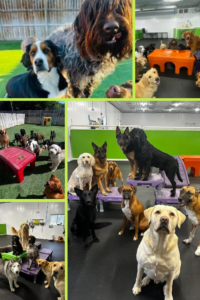
All Dog Daycares Are Not Created Equal…Your Guide to Evaluating the Best Option for Your Dog

Join us for Part 2 in our 4-part series on how to assess and choose a good dog daycare. In this post, we will discuss staffing. A dog daycare can only be as good as the team that supports it. From the person with the pooper scooper in hand to the person making policies, it is the people who create and maintain a good (or bad) experience for the dogs in their care. I will separate this post into several sections, with questions you can ask a prospective daycare about their staffing. In each section, I will give you my opinions on what makes for a good dog daycare team.
Longevity and Turnover:
- What is your average staff turnover rate?
- Why would this be important to the care your dog is receiving? The answer is consistency and experience. When staff is turning over constantly, there is no consistency for the dogs. It also leads to being short-staffed. High staff turnover means that there are new trainees constantly and expertise can be in short supply.
- The pet care industry suffers some of the worst employee turnover rates, sometimes as high as 125%. I believe this comes from the concept that working with animals is always fun and fulfilling, so people want to do it. But once the reality of working with pee, poop, vomit, and overly energetic adolescent dogs sinks in, it doesn’t seem quite as fun, so the duration of employment can be pretty short. This doesn’t have to be the way it is though. By finding the right team members, setting expectations, and providing support, people can succeed and thrive in the pet services industry.
- Daycares should know their staff turnover rate. There were times when we did not and that was a mistake. Once we started tracking our employee turnover rate, we realized that we needed to take measures to improve our culture and our processes. Our goal is less than 20% and we have hit that target from 2019 until this year. We had a turnover rate of 26% in 2023, which was up from our previous years. This was due to some of our staff moving on in their lives (college graduation, careers, moving). We attribute this low turnover rate to thoughtful hiring, our staff training program, and efforts towards creating a positive work culture.
- What is your average length of employment?
- Do team members stick around? Are there team members who are making dog daycare their career? These are the questions that can be answered by looking at the length of employment. 44% of Play All Day’s team has been with us for 3 years or longer. Our average length of employment is 3.8 years. We don’t have statistics to compare to in the pet services world, but based on feedback from my colleagues across the country, I would venture a guess that most daycares have a one-year average. For me, the average length of employment speaks to happy employees who are where they want to be, doing what they want to be doing. It speaks to careers rather than jobs.
- What is your target pool of candidates when hiring?
- Where a daycare is hiring from does matter. Are the playgroups being monitored by high school students working their first job or by adults who have chosen to work in the dog daycare world? High school students can be very good with dogs. That is not the issue. The issue is consistency. High school schedules do not allow for a commitment to becoming an expert dog handler. Play All Day has found that college students, on the other hand, do make for good daycare team members. Their schedules are more flexible and they can commit to becoming experts. And it’s a bonus when the college student is enrolled in animal-related studies. But we really love it when we can find non-students who are looking to make working with animals their career.
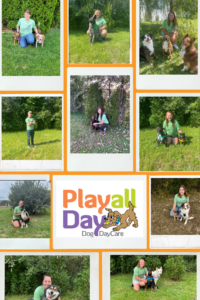
Play All Day has 10 staff members with 3 years of experience or more. Left to right, top to bottom, we have: Tera: 9 years, Aly: 8 years, Kim: 9 years, Al: 5 years, Kate: 11 years, Mae: 5 years, Paige: 3 years, Noah: 5 years, Jade: 4 years, Kendall: 4 years. 63 years total of dog daycare experience in this picture, not including April’s 13 years of experience.
Employee Training:
- Do you have a formal training program for new employees?
- If the answer is no to this question, it is a red flag. This is another non-negotiable characteristic of a dog daycare that I would choose for my own dog. Team members need education, hands-on training, and supervision before they assume responsibility for a dog group. I believe that lack of training is one of the biggest contributors to the high staff turnover rate in the pet industry.
- Play All Day’s training program includes education on dog body language, playgroup dynamics, dog behavior, dog training, and how to manage unwanted behaviors. This is taught using video resources from professionals in our industry, reading material, and one-on-one training with a mentor. Our employee handbook and policies and procedures are the guide that the new staff member can follow from day one.
- How long is new staff trained before becoming responsible for a playgroup?
- Believe it or not, there are daycares that allow new staff to oversee a dog group within 24 hours of starting employment. This is an unsafe practice because there are so many skills that need to be acquired and knowledge to be gained before one can safely manage a playgroup.
- Play All Day offers two weeks of training with the same mentor. Prior to declaring the new staff member competent, they are monitored on video camera to make sure that they can successfully manage a playgroup solo. They must also have their competency checklist completed. After training, new staff members are followed closely for the first three months of employment.
Policies & Procedures:
- Do you have policies and procedures for all job responsibilities?
- My healthcare background has helped me to see the importance of this issue. Without P & P’s, staff members do not have a guide. They do not have a resource to help them make the right decisions. Expectations cannot be set. Lack of P & P’s results in everyone doing the same task just a little differently and ultimately there is not a correct way of doing it. I believe this is another part of the high turnover rate in our industry.
- How do you monitor adherence to policies and procedures?
- Without a system for monitoring adherence, P & P’s are just documents without meaning. A daycare should have systems in place to address adherence. At PAD, we monitor staff on video camera randomly, giving feedback and listening to concerns. Oftentimes, when an employee is not following policy, it is not out of laziness. It is usually from a lack of understanding. Performance monitoring allows these misunderstandings to come to light and to be addressed. The employee learns something and sometimes PAD learns something and re-writes a policy so that it is clearer.
Continuing Education:
- Does your staff participate in continuing education?
- Opportunities for team members to learn can only benefit your dog, whether it is pet first aid, topics on dog behavior, or dog training. Just like our dogs need to have mental stimulation, so do employees. Having opportunities to become an expert in your field is important for career-minded employees. It is the difference between a job and a career. And ultimately, the dogs benefit from this continuing education.
- We believe in continuing education at PAD. We recently implemented a program that incentivizes learning and advancement. It is called the Leash Board. On the leash board are the requirements for different levels of achievement. As an employee reaches each level, a new slip leash of a different color is awarded to recognize their achievement. Slip leads are a part of every dog handler’s uniform and an important tool. The different color not only signifies their achievements but is also a badge for new employees to recognize and know who to go to for information.
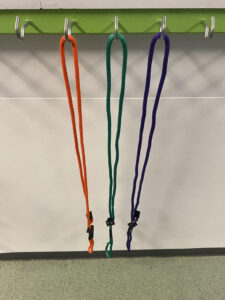
- Are there opportunities for advancement in your organization?
- For those that have chosen to make dog daycare their career, advancement within the organization is an opportunity to grow and shine. At PAD, opportunities exist within dog care, our market, customer relations, and leadership. Without the opportunity to grow, talented people will move on.
 Culture:
Culture:
- Does your team operate within a shared set of values?
- Culture is so important to an organization….any organization. I did not fully recognize this when I started PAD. We were very small and it just so happened that our team was all on the same page. But as we grew and more personalities joined us, I saw that we had differing views on what a good dog daycare should be. As the leader, it was my responsibility to unite us with a set of shared values. We now use these values to set expectations when hiring, to help us make business decisions, and to coach current employees. We feel our values are so important to our culture, we have them on our employee application. You can view them here.
Staff In Action: What would a post on Staffing be without a little show-off time from our staff at Play All Day.
- Follow this link to watch Jackie perform PAD’s longest sit/stay in history. I think it is around 2 minutes. It is not riveting YouTube watching but you will get the point of it. These are dogs in a daycare with all of their buddies and lots of distractions. They could be playing with each other, chasing balls, or peeing on things. But they choose to work with Jackie for a reward.
- Tricks are a great way to get your dog to focus on you and great way to insert a pause in daycare. Aly is working with Gemma on her favorite trick, twirling. You can view it here.
- We talk a lot about impulse control at PAD because it is so important to a well-run daycare. One of the things we work on a lot with our new team members is training impulse control. Here it is in action at the gate, asking the dogs not to cross over the invisible gate boundary. Click here to view.
- Follow this link to see pictures of the PAD team and to read their bios.
A well-trained, committed team of staff members is vital to the success of a dog daycare. If you are considering daycare for your dog or are evaluating your current daycare, a look into how the daycare is staffed is worth your effort. Managing dogs in a playgroup does not sound like a difficult job, but it is. It takes talent, skill, patience, and the right attitude. Not everyone is cut out for it. But those who are, and receive the right training and support, make a huge difference for the dogs in their care.
Part 1 in Not All Dog Daycares Are Created Equal…Your Guide to Evaluating the Best Option for your Dog
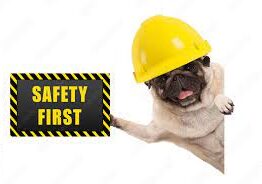
Welcome to part one in our four-part series on how to evaluate and choose a dog daycare. This week we will focus on safety. Safety is a top priority at Play All Day and in my opinion, should be a top priority in any dog daycare. Most daycares will say that this is a top priority for them, but how can you really know for sure? Never fear, some expert tips are coming your way. We will look at facility design, processes, programming, and discuss how they can affect your dog’s physical and mental safety. The post is organized by topic, with questions to ask a prospective daycare and tips on what a good answer might be.
Fencing: Fencing should be secure to keep dogs in and to keep dogs from other playgroups out. Questions to ask regarding fencing.
- What material is the fencing made from?
- Ideally, fencing should be made of a solid non-see-through material such as wood or PVC. A chain link fence is more easily climbed and does not provide any type of visual barrier. Arousal levels are much higher when dogs have open vision to everything around them. It leads to barking and fence lunging in many cases. Managing arousal is one of the most important safety factors that a daycare should address. Excessive barking is a symptom of overarousal. More on this topic later.
- How high are the fences?
- Exterior fencing should be 8 feet high and have smooth sides so that dogs cannot scale or climb to escape. While daycare is fun for most dogs, there are times when a dog can become anxious. New dogs can take time to feel comfortable in a new environment. Escape can be a goal and it should not be easy for it to occur. Quality fencing of the right height and construction are imperative.
- Are there gates on the outside play areas?
- Outdoor play areas should not have gates. This is one of the non-negotiable safety factors for me. No matter how well-intentioned a facility is to make sure that gates are always closed and secure, there will come a time when something happens, and the gate is left open. So it is best to not have any gates on outside fencing.
Escape Prevention: Question to ask.
- How many doors and gates separate a dog from their playgroup and outside?
- In the dog daycare world, it is always best to imagine the worst-case scenario. What if a dog gets out of the play area or a crate? How many doors are between them and escaping to the outside? There should be multiple barriers to prevent this from happening. Two is my minimum. And there should be written policies on closing doors behind you.
Staff: This topic is so important to the safety and well-being of your dog; we will address it in its own blog post next week. But it is a key component of a safe daycare, so needs to be mentioned for this post. Next week, we will discuss the quantity and quality of the staff, but for today, we will address supervision only. Questions to ask.
- Will my dog be supervised 100% of the time when with other dogs?
- If the answer is anything but yes to this question, your dog will not be safe. Dogs in playgroups need eyes on them 100% of the time.
- Does the physical setup allow for the staff member to see all the dogs at the same time?
- For Play All Day, supervision is being in the same physical space with the dogs in our care. It is having an engaged staff member who is trained in dog body language and behavior, watching the dogs interact, listening to the tone of their play, and being within steps of all interactions. If there is an outdoor area, and the dogs are allowed to come and go freely from inside to outside, there should be a staff member inside and outside at the same time. Anything less is unacceptable.

Programming: This is another topic that is so important, it will also be its own post in a few weeks. But it plays a key role in safety so it must be mentioned here in those terms. In our post on programming, we will talk about the quality of programming and how it affects your dog’s experience. In this post, we will address the pertinent safety aspects of programming. I noted earlier, when discussing fencing, that managing arousal is important for a safe daycare. And just like good fencing can help to prevent over-arousal, so can good daycare programming. Having a program in place that manages over-arousal, manages barking, and inserts pauses and rest periods will decrease the chance of incidents that can lead to injury. Questions to ask.
- Will my dog get a break during the day?
- Breaks in the day from free play are beneficial in decreasing arousal levels. Short timeouts when a dog is over-aroused does wonders. And a scheduled naptime helps to prevent dogs from getting grumpy (toddler-tired).
- Does the staff intervene in dog/dog interactions?
- Staff intervention, quickly and efficiently, can help to prevent a dog fight. Something as simple as a staff member inserting a 10-second pause in play between two dogs can prevent it from going over the top and turning into a fight.
- Does the staff interact with and train the dogs?
- Training not only helps the staff to manage the dogs in playgroup but also decreases arousal by channeling energy and engaging the brain. And Bonus, your dog is getting trained!
- Are there crates in the play areas for timeouts?
- The ability to implement a quick crate timeout is crucial for managing a playgroup. If there are no crates available in the play area, staff cannot quickly implement a timeout.
- How is barking managed?
- Barking is a barometer of arousal levels. A quiet daycare is a sign of a well-managed daycare. This is an easy one to evaluate. Drive by a daycare during different parts of the day (but especially morning) and roll your window down. What are you hearing? An occasional bark here and there is not an issue (hey, we all must express ourselves), but constant barking is a sign that arousal levels are high and that there is no structure to the daycare.
- Is there a check-in and check-out window?
- It is a customer convenience to be able to drop off and pick up whenever you want, but is it in the best interest of all the dogs? Does it create a safe environment? The answer is no. Check-in is the most arousing part of a day at daycare and to have it go on all day keeps arousal levels high and unmanageable.
- Does the daycare require scheduled appointments?
- Scheduled daycare allows for careful consideration of what dogs go into each playgroup. It also allows the daycare to prevent over-booking and make sure staffing is adequate for the number of dogs attending. Drop-in daycare does not allow for structure and planning.
- Is there an attendance policy?
- Consistency in attendance plays such a huge role in safety. Sporadic attendance leads to higher arousal levels. Staff can spend most of their time dealing with behaviors from non-regular dogs and cannot focus on all the dogs in their care. Play All Day introduced a weekly attendance policy in 2012 and our incidents decreased dramatically.
Physical Space Per Dog: Question to ask.
- How many square feet per dog do you have in your play areas?
- Unfortunately, there is not an industry standard on this, but experience should teach any good daycare owner what this number should be. For Play All Day, we shoot for 75-80 square feet per dog in our big dog groups and 60-65 square feet per dog in our small dog groups. Our experience has taught us that exceeding these guidelines leads to overcrowding, increased arousal, and increased incidents between dogs. There are daycares in our area that will push this number to half of what we require at Play All Day. This is a question I would ask of any daycare I was considering sending my own dog to. To me, this is more important than the staff-to-dog ratio.
Dog/Dog Introductions: Those who already use daycare know how excited your dog is to get to daycare in the morning. This is the highest arousal time in a dog daycare. How the dogs are managed from the moment they walk through the door until they enter the playgroup is an indicator of how safe a daycare is. Questions to ask.
- Where does my dog go when I hand him off to you?
- Because this is such an exciting part of the day, it is up to the daycare to manage the arousal and help to deflate it a bit before introducing the incoming dog to the rest of the group. Play All Day uses a holding area to help dogs decompress over 5-10 minutes after arrival. This can be a crate in the hallway or the holding area just inside of the playgroup. How long is dependent on the dog arriving, the number of dogs already in the playgroup, and the tone of the group.
- How will my dog be introduced into the group?
- Dogs that are already in the playgroup may be crated during introductions, especially if they are over-exuberant greeters or have space issues. Once the arriving dog shows signs of relaxing, he is allowed into the playgroup and goes right to the outside area to relieve himself. The staff does not allow the dog to be mobbed as he enters. He then comes inside and if the staff feels that the energy level is appropriate, the dogs in crates are let out and allowed to greet gradually. The process only takes a few minutes but does wonders to decompress and make for safe greetings. Unfortunately, many daycares do not have a process for introducing arriving dogs to the playgroup and simply just let the dog into the group. This usually results in the dog being mobbed by the dogs already there and it is very stressful and arousing. Some dogs are just old pros and can manage this, but the average dog finds it overwhelming. It is not safe, and it is not in your dog’s best interest.
- Click here for a video on a healthy and safe dog introduction at PAD. And another one here.
New Dogs: Questions to ask.
- Do you review an enrollment form with the dog’s history before evaluating them in the daycare? Do you ask if the dog has been dismissed from other daycares?
- Play All Day has been teased about our enrollment form being so long and detailed and that most people did not have to provide so much information for their human child’s daycare. That is for a reason. The enrollment form gives us important information about the dog’s behavior and past. I would estimate that we can tell from the enrollment form alone, whether or not a dog is going to be a good fit, 75% of the time or more. And that information helps us to plan the dog’s introduction into the playgroup, so it will be successful and so that all the dogs will be safe.
- How do you physically introduce the new dog to the existing dogs in the daycare?
- We discussed how we introduce existing dogs into the group each week, but this is even more important when it is a new dog. This is a slow process and happens one-on-one with a trusted dog and one of the dogs is always on leash…most often both. All our new evaluations are scheduled at times when the daycare is not full yet. Extra staff is on hand to help manage the introductions and only our most skilled staff, trained specifically in introductions, perform this process.
- Click here for a video example of a safe new dog introduction at PAD. And Part 2 here.
- Do you deny entry to dogs that are inappropriate for a daycare setting?
- Not all dogs are a good fit for daycare. It is not fair to the dog who is not a good fit and it is not fair to all of the other dogs if the dog is allowed into the program. Daycares should have certain criteria that should be met for a dog to participate in daycare.
Incident Tracking: You can’t evaluate what you don’t measure. You can’t improve if you don’t evaluate. Questions to ask:
- Do you track incidents in your daycare?
- Incidents happen in any daycare, no matter how well-run it is. Dogs are living beings with personalities and just like us, life events affect them and their behavior. And some dogs will act out because of life changes (health issues, home changes, etc). The result can be a dog/dog incident. Most of the time these incidents are just a lot of noise and don’t result in injury. But sometimes they do. Both should be documented and evaluated, and parents should be notified.
- Do you routinely review the incidents and evaluate processes based on your findings?
- The documented incidents and close calls should be evaluated regularly to look for patterns. There is so much to learn by evaluating incidents. Many of our policies came from a careful evaluation of incident reporting. A few years ago, we had an outbreak of minor injuries related to the physical environment. They were from things like a gate latch that was wearing out, a crate wire that had rusted and broken away from the weld, and other small things like this. From this experience, we realized that our building was aging and that things were wearing down. As a result, we implemented monthly safety walkthroughs. Our Manager and Facility Supervisor walk through the buildings each month, looking for just these types of building wear and tear that could potentially affect a dog’s safety. Minor issues are addressed before they can cause an injury.
You made it through this long post. It most likely means that you are serious about finding the best option for your dog. Play All Day’s mission is to provide a fun, safe, and enriching environment for the dogs in our care. Safety is our highest priority. I wrote this post based on my experience with creating a safe dog daycare. There are many ways to accomplish this, but there are a few non-negotiable items. Not taking your dog to daycare is a better option than taking them to a daycare that does not have 100% supervision, a thorough enrollment process, and a safe dog introduction process. If you can’t find these, just walk away. Your dog will thank you.
I welcome your questions. Email me at april@playalldaydoggiedaycare.com 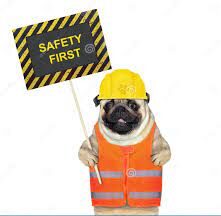

Dog daycares have become increasingly popular over the past decade, and the options in the Peoria area have increased in the past five years. Play All Day opened in 2011 and was one of three options. Today, there are at least ten options. Daycares are popping up like Starbucks.
On the one hand, this makes me very happy. It means people are seeing the importance of socializing their dogs. It means that people are considering their dogs’ well-being in terms of exercise, mental health, and happiness. Overall, it validates my long-held belief that people love their dogs and want the best for them. Yay dog people! Well done.
On the other hand, it raises some concerns for me. Our lives are so busy and an active dog can really add to the stress of life (jobs, kids, family, social life). Getting the dog out of the house and wearing him out can become a high priority. Having more daycare options available to a Pet Parent is great, but are they good options? Just because a dog daycare has opened and is available doesn’t necessarily mean that it is a quality facility that will keep your dog safe and meet your dog’s mental and emotional needs. People want to do well by their dogs, but how to make a good decision when there are so many options. It is a challenge for the average dog person to tell the differences between one daycare and the other, especially in today’s world of heavy-handed marketing and social media. Practically anything can be made to look positive in this environment. So, how can you get to the truth and make good choices for your dog? That is the point of this blog series.
I’m often asked by clients when they are moving to a new community; “How can I find a new daycare that I can trust?”. At this point, I usually offer to do some searching for them. You can learn a lot from searching a website and social media posts. Most of us will type “dog daycare near me” into the search engine. But what then? There are green flags and there are red flags if you know what to look for. Once I narrow the search down, I provide a list of questions to the client and direct them to call the daycare prior to starting and to ask the questions then and throughout the enrollment process. Asking the right questions can set you up for success when selecting a dog daycare.
Over the next several weeks, I will detail the traits that I consider to be important to a quality dog daycare program. Some of the topics I will address are safety, staffing, and program details. And to wrap it up, I will address how to assess the value you are receiving based on what you are paying.
You may be wondering what makes me qualified to write this and why my opinion matters. Kudos to you. We need more critical thinking in our world today. Those who already know me and know Play All Day will understand that the opinions in this piece are legitimate and well-founded in research and experience. For those who do not know me, I invite you to read through each piece and determine for yourself if the things I am saying make sense. I ask you to question and consider. I invite you to read my daycare biography so that you can see who I am, and how we came to where we are today.
Join me over the next several weeks and get an insider’s look into what makes a quality daycare. Hopefully, the information will guide you as you search the results of “dog daycare near me”. Next week, we will jump right into what I consider to be the most important factor in choosing a dog daycare, Safety.
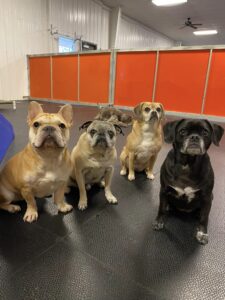
Unless you have been hiding out from the world, you’ve probably heard about the sensational “Mystery Illness” affecting dogs. In the past 48 hours, social media and news have put this front and center. It’s not actually new….it’s been going around since early summer. But for some reason, it is now the hot topic. Currently 5 states have seen cases, Illinois being one of the five.
I’m writing this post to give you Play All Day’s stance on the topic, as it stands today, with the knowledge that we have in hand.
Play All Day’s stance is that this appears to be another variation of Canine Cough. It has not hit our area yet. It may or may not. When it does, we will handle it as we normally handle Canine Cough. Dogs will not be permitted at daycare until their symptoms subside. If more information does come to the surface that suggests we should vary from our policies, we will do so. Our mission is to provide a fun, SAFE, and enriching environment for the dogs in our care and we will keep that mission at the forefront as we follow this and make decisions.
For now, it is business as usual at Play All Day.
For more information, please continue to read.
What is it and what does it mean for you and your dog?
- Bottom line, it is an upper respiratory infection (URI). URI is a general term to describe any infection of the upper airways, caused by a bacteria or virus. The “mystery” in this situation is that the testing has not shown the usual culprit of viruses and bacteria that have been the cause in the past. We usually see Mycoplasma, a bacterium, as the cause of Canine Cough (URI’s) in the Peoria area.
- The other difference about this URI is that the cough seems to be more chronic, sometimes lasting weeks. And they have seen more dogs develop pneumonia than usual. Pneumonia is always a risk with a URI and that is why we encourage you to go to your veterinarian when we have a Canine Cough outbreak. Antibiotics not only treat the underlying cause but can help to prevent pneumonia from developing.
- Some dogs have developed severe pneumonia and ultimately died. But these are very rare and seem to only be affecting immunocompromised dogs. Unfortunately, this is the thread that the news media has latched on to and they do not hesitate to sensationalize it to grab your attention. The deaths are rare and that should be their headline.
- The real news is that there is a new form of URI and at this time, the cause has not been identified.
What should you do?
- First, my advice is not to panic. Read the social media posts and news stories entirely, not just the headlines. If it feels sensational, move on to the next source that gives you facts, not drama.
- This is not something that is going to go away in one week. If you are thinking about stopping socialization of your dog (walks, daycare, boarding, grooming, going to the Vet, play dates), it will be a long-term decision. Cessation of dog/dog activities will have to occur for months for you to truly protect your dog. Keeping them away from other dogs for one week will not help. As I said earlier, this URI has been around for months….it did not just happen in the past 48 hours. And stopping socialization is not a guarantee. I can think of two households who were affected by Canine Cough this past summer. The dogs do not go to daycare, boarding, grooming, dog parks, or have play dates and they still ended up with Canine Cough.
- Talk to your veterinarian. The Canine Influenza Virus vaccination may or may not help. This is a conversation you should have with them.
- If you do have an immunocompromised dog at home, dog/dog socialization outside of the home may not be the wisest choice at this time. Old age is not necessarily immunocompromised. I’m talking about dogs with chronic illness or puppies that have not been fully vaccinated.
- If your dog starts coughing, keep them home, and let us know. We will be tracking this closely.
As always, we appreciate the trust you place in us, in caring for your family member.
- What is Canine Cough (CC) and why did my dog get it?
- CC is a general term for an upper respiratory infection that causes a cough. The cough is often triggered by activity or excitement. So your dog may seem perfectly normal one moment and then begins coughing during exercise, excitement, or anything else that causes the airway to be stimulated. Some dogs will only cough once or twice a day and others cough frequently.
- CC can be caused by multiple different bacteria or viruses. We have most often seen mycoplasma (a bacteria) as the culprit. CC is transferred from one dog to another by saliva or air droplets when a dog exhales. Social dogs are at a higher risk because they are in contact with other dogs and are often playing with their mouths, sharing water, and sniffing the ground where these droplets may reside.
- Are Kennel Cough and Canine Cough the same thing?
- Yes, Kennel Cough is the old terminology, given because that is when dogs most often got it….when they were boarded. Over the past few decades, dogs have become much more social. Dog Parks, dog-friendly stores, and daycares are all available now and are likely places for dogs to get contagious illness. So the term kennel cough doesn’t quite cover it anymore.
- My dog was vaccinated for Bordetella, with the “kennel cough” vaccine. Why did they still get it?
- Bordetella is just one of the multiple bacteria that can cause a cough. And it’s a nasty one. Thankfully there is a vaccination to help prevent it in dogs. The cough that is associated with social dogs in daycare settings is rarely Bordetella.
- How serious is CC and will my dog be seriously ill?
- Any upper respiratory infection could be serious, dependent on what type it is, the health of the dog, and whether or not treatment is given. Most cases that we see in our community do not cause any serious threat, even if untreated. But it could lead to pneumonia and that is serious. So we always recommend that you see your Veterinarian if your dog begins coughing.
- Will better cleaning practices at the daycare prevent CC?
- While good cleaning and sanitizing is important in the daycare setting for a whole host of reasons, it unfortunately will not totally prevent the spread of CC. The primary risk is playing with the other dogs who might be carriers.
- Does Play All Day restrict affected dogs from attending daycare?
- Yes. But unfortunately, some dogs carry the bacteria/virus and do not have any symptoms. Without a cough, we do not know that a dog is affected. That is how it starts and spreads so quickly. But once a dog starts coughing, we restrict daycare access.
- How long will my dog be out of daycare if affected?
- We encourage all our affected dogs to see the Veterinarian and begin treatment if recommended. If treated with antibiotics, we ask that you keep your dog home for one week after the start of antibiotics (assuming your dog is healthy and not coughing). If you decide not to treat your dog, we ask that you keep your dog home for 2 weeks from the start of the cough (assuming your dog is healthy and not coughing).
- Will my dog get CC every time it comes through the daycare?
- It has been our experience over the past 12 years that dogs do not repeatedly get the cough. Our statistics at the daycare show that only a very small number will get CC a second time. There seems to be some sort of immunity that is developed. We cannot guarantee that, but that has been our experience over a long period of time with many dogs in our sample.
- If my dog is exposed to CC, how long will it take for them to have symptoms?
- This is variable. We’ve seen dogs get symptoms within a few days and others after a week. That’s what makes it so darn hard to manage.
- I have other dogs in my home who do not attend daycare. Will they be at risk?
- Yes, they will. And you should pay special attention to this if your dogs at home have risk factors of being older, ill, or very young puppies. Talk to your Veterinarian about this as you consider the risks.
- Can I just keep my dog home from daycare if there is a CC outbreak?
- Whether or not you bring your dog to daycare, for any reason, is always your choice. Related to CC, you would have to keep your dog out for 4-6 weeks to fully protect them. That is usually the amount of time it takes to clear out and move on. While daycare increases the risk, holding daycare does not totally prevent the risk. There are cases in which dogs who are not social at all, still end up with CC somehow. And remember that if your dog has had it in the past, it is likely that they will not get it again.
- If you decide to pull your dog from daycare temporarily, we will discuss Membership issues with you at that time.
- Other thoughts:
- CC is a pain in the butt for you, your dog, and the daycare. It’s very much like children getting a “bug” at the daycare. It causes disruption for the parents, for the daycare, and the child feels poorly. But it is part of life and part of being social. We like to think of CC in terms of risk vs. benefit. Yes, CC is a risk of daycare, but the benefit is a well socialized, happy, tired dog. In this case, we think the benefits outweigh the risk.
- This FAQ is informational and not intended as medical advice. Each dog is an individual and that should be considered. We strongly encourage conversations with your Veterinary team as you consider this issue.

Play All Day is moving to a Membership Model. What does that mean for you?
- PAD, in some ways, already operates as a membership since we require regular attendance and only offer boarding services to our existing daycare clients. This change will not affect that aspect of our daycare.
- Memberships will be structured on a monthly basis. Currently, our clients have the option of paying weekly or purchasing discounted packages of 10 weeks (package size dependent on number of days your dog is attending). Membership for all PAD clients will now be a monthly fee instead of packages or weekly payments.
- The monthly membership fee will be based on how many days a week your dog normally attends daycare.
- Memberships are month-to-month. There are no contracts, and you can cancel your membership at any time.
- Membership fees are non-refundable. If you need to cancel a day of daycare, that day will not be refunded. But with proper notice, we will work with you to reschedule that canceled day (within the same week) to a different day.
- We will take emergencies, weather events, contagious illness, and other unusual situations into account, within reason. We will get you details on this after we implement the new model.
- You will still be able to add additional days of daycare as needed, as long as space is available.
- As promised during our last price increase in 2022 (no price increases until 2025), you will not see a price increase with this change to a Membership Model. The new monthly membership fee mirrors the existing weekly rate you are currently paying. Multi-dog discounts are still in place.
- If you currently pay weekly and do not buy packages, you will see a discount in your weekly rate, but you will be required to pay for a month at a time, as opposed to weekly.
Why the Change?
- As always, the PAD mission is our guide when we feel the need for a change. Our mission is to provide a fun, safe, and enriching environment for the dogs in our care.
- In the past year, we have had record attendance and a consistent waiting list for new dogs to enter our program.
- We’ve also had a record year in canceled daycare days, the majority of which occur the morning of the scheduled day. These last-minute cancellations have become so prevalent that we have had to increase our capacity for each playgroup, under the assumption that we will have a good number of cancellations each day, in each playgroup. But on occasion, the cancellations are not as high as anticipated, and our groups are over capacity. Thankfully, due to the training that we do with our dogs and the skill of our staff, we have been able to achieve this safely. But it is not our ideal and does not reflect our mission.
- Additionally, our playgroups are not as stable as we would like them to be due to overbooking for anticipated cancellations. We have to do quite a bit of shifting of dogs from one playgroup to another based on which dogs cancel in which playgroup. We much prefer stable groups. This leads to decreased arousal, greater dog experience, and a greater ability for our teachers to do enrichment such as training and games.
- We have been considering this change for over a year, but really wanted to keep the flexibility of cancellations available to our clients. “Life Happens” and sometimes you just can’t make it into daycare. We still believe that and understand that. But we must balance that understanding with the ability to accurately determine our capacity so that we can keep all of the dogs in our care safe and happy. With this model, you may not always be getting your full money’s worth if you have to cancel, but your dog’s spot in our playgroups is secure and you can rest assured that we are not overbooking.
What Do I Need to Do Now?
- If you have a package, when your current package runs out, we will convert you to the new 4-week Membership packages.
- If you currently pay weekly, we will ask that you buy a 4-week Membership package, no later than March 13. You will be saving $2/visit with the new package.
- The new cancellation policy will go into effect on March 13.
4-Week Membership Rates:
- 1 Day/Week: $128
- 1 Day/Week, 2nd Dog: $120
- 2 Days/Week: $248
- 2 Days/Week, 2nd Dog: $232
- 3 Days/Week: $348
- 3 Days/Week, 2nd Dog: $324


